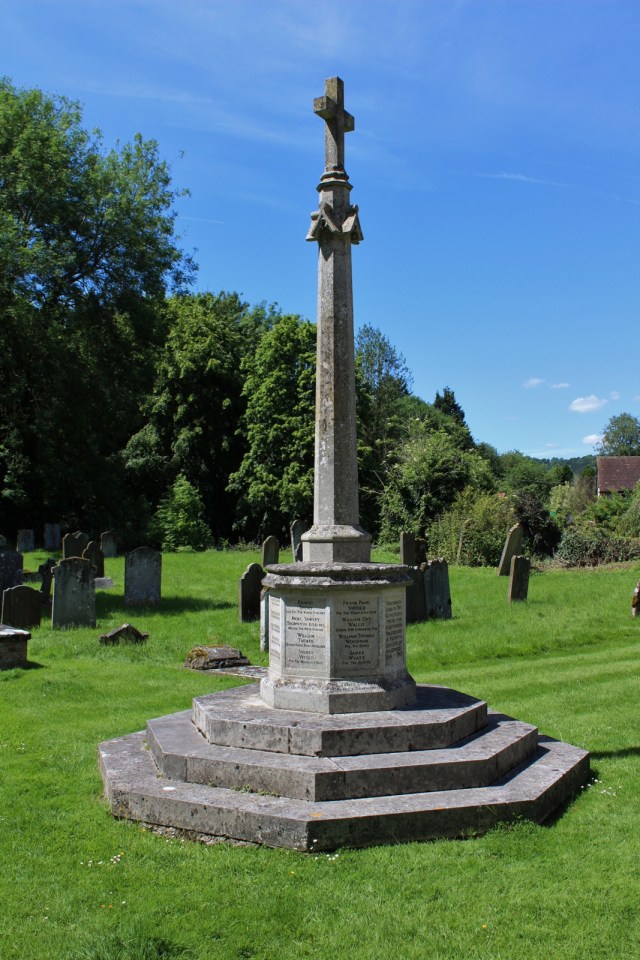Another locked church, I’m afraid,…
…but the war memorial makes our visit worthwhile.
The panels of the memorial list twenty nine men killed in the Great War, with the names of eight Second World War casualties on the angled base of the plinth beneath. Two Navy stokers are included among the Great War names, one, on the left panel here, who died when the submarine E6 was sunk by a mine in the North Sea off Harwich on Boxing Day 1915 and went down with all hands. A trawler had hit a mine and sunk in almost the same position not long before, but despite a warning from a British torpedo boat to steer clear of the minefield, the E6, for reasons unknown, continued on its course to disaster.
The second stoker on the memorial served aboard H.M.S. Aboukir. On 22nd September 1914, in the space of an hour, three obsolete British cruisers, H.M.S. Aboukir, H.M.S. Hogue & H.M.S. Cressy, patrolling the North Sea’s extreme southern reaches, some twenty five miles north of the Hague, were attacked and sunk by a single German submarine, the U-9.
The Aboukir begins its death roll in Norman Wilkinson’s painting of the action. Aboard the three ships, over 1,450 men, mostly part-time sailors of the Royal Naval Reserve, were drowned. Incidentally, we visited the grave of a man who died on H.M.S. Houge that day (a boy really – he was fifteen) not so long ago at Witley Cemetery.
Elsewhere, I spy two CWGC headstones,…
…the first…
…Private W. Miles, Royal Army Service Corps, who died on 6th September 1918 (he had actually been transferred to the Labour Corps before his death),…
…and the second,…
…Private Alfred Mackrell, Cheshire Regiment, who served under the name Private Peace, and who died on 22nd July 1918 aged 27.
Another CWGC headstone,…
…this time a Queen’s lance corporal who died in 1942.
The grave of Major Noel Shipley Thornton D.S.O., M.C., Rifle Brigade, or you’d think it was, but apparently, according to the CWGC, he’s buried in Abbeville Communal Cemetery Extension, on the Somme. Enlisting in the Public Schools Battalion in September 1914, by March 1918 he was commanding 7th (Service) Battalion, Rifle Brigade. Severely wounded east of Amiens on 3rd April 1918, in the final days of Operation Michael, the first phase of the German Spring Offensive, he would die on 10th April at No. 2 Stationary Hospital in Abbeville, where he is indeed buried in the communal cemetery extension. Both his D.S.O. & M.C. were awarded posthumously.
And finally,…
…a couple of pictures of the nearby Betchworth Village War Memorial Hall,…
…because, as Mallory famously put it, it’s there.





























Nice little church thank you
Indeed. I shall get inside at some point. Cheers Alan.
Very interesting. As soon as I read HMS Aboukir I thought, that rings a bell.
Looks a bit like Everest that memorial hall lol, they’re rarely the prettiest of buildings. Shame really.
I shoulda superimposed a shot of Hillary & Tensing on top of the roof…….well, maybe not.
Thank you for another interesting article.
It is such a shame that in this day and age we have to lock our churches. I wonder what our brave soldiers of the past would think of things as they are today.
It is a shame, although church theft is hardly a modern vogue – the means to get away quickly, however, is. Cheers Steve.